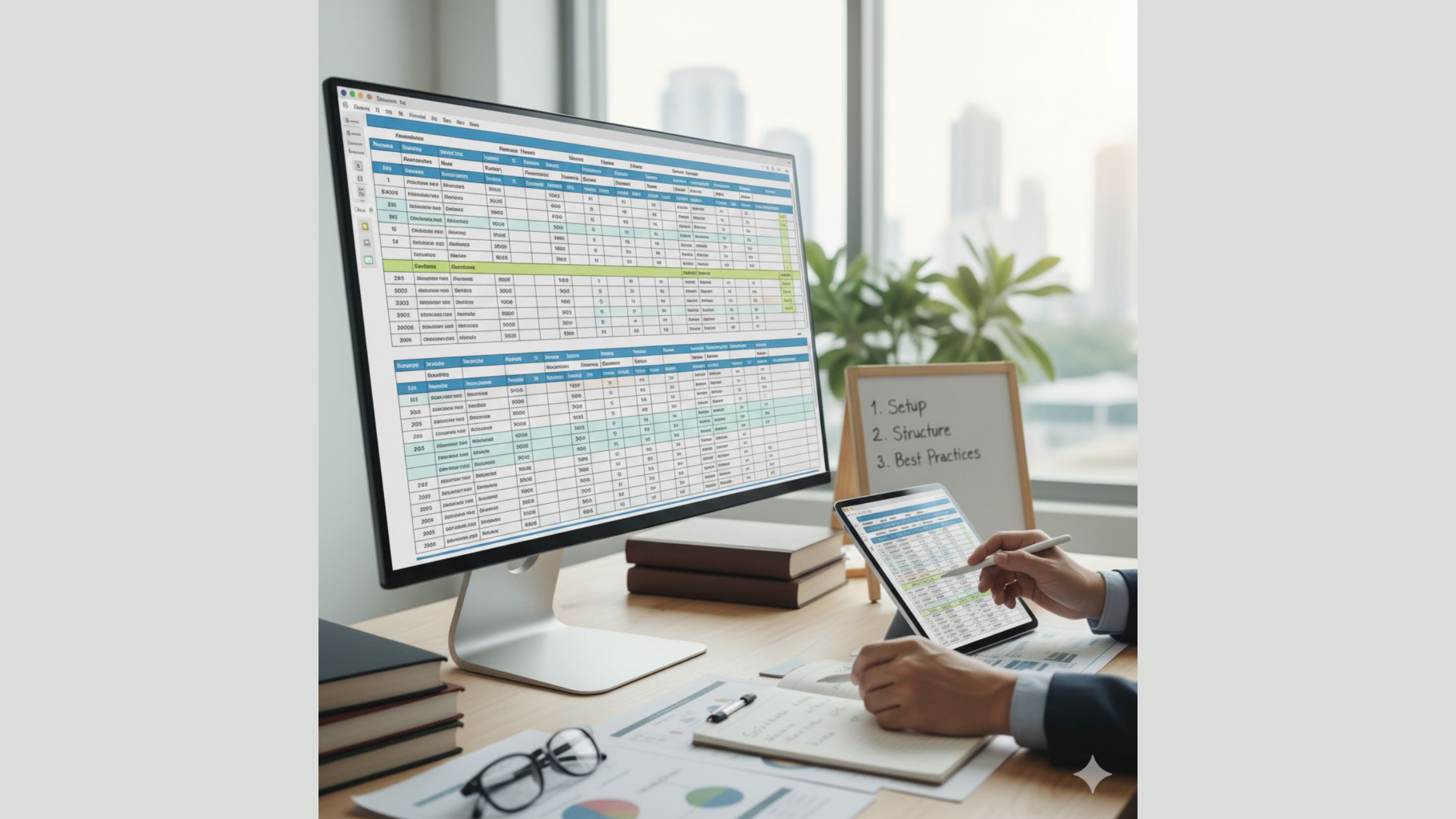A chart of accounts is the master list of every account your business uses to record money in and money out. It groups accounts by type such as assets, liabilities, equity, income, and expenses, gives each a unique number and name, and maps directly to your financial statements. Get this right and your books stay clean, reports make sense, and tax time is calm.
Now let’s break it down and build a smart chart of accounts you can trust.
What is a chart of accounts
Direct answer. It is an indexed list of accounts with numbers and names that classify every transaction your business records. Each account rolls up to the balance sheet or the income statement so you can see where money sits and how it moves.
Why the chart of accounts matters
- Clear reporting that owners and lenders can read in minutes
- Faster month end close and easier bank reconciliation
- Cleaner tax prep and fewer reclass entries
- Better margins and cost control because expenses are grouped the right way
- Less chaos as you grow because the structure scales
The five core account groups
All charts of accounts hang on the same simple frame.
- Assets
- Liabilities
- Equity
- Income
- Expenses
Everything you add should fit one of these. If it does not, stop and rethink the design.
A simple numbering system that works
Use four digits. Leave room to grow. Keep similar items together.
- 1000 to 1999 Assets
- 1100 Current assets
- 1200 Cash and cash equivalents
- 1300 Accounts receivable
- 1500 Inventory
- 1700 Fixed assets
- 2000 to 2999 Liabilities
- 2100 Current liabilities
- 2200 Accounts payable
- 2300 Credit cards
- 2400 Payroll liabilities
- 2600 Loans
- 3000 to 3999 Equity
- 3100 Owner equity
- 3200 Retained earnings
- 4000 to 4999 Income
- 4100 Product sales
- 4200 Service income
- 4300 Other income
- 5000 to 6999 Cost of goods sold
- 7000 to 9999 Operating expenses
Pick ranges and stick to them. Consistency beats cleverness.
Starter chart of accounts example
Use this as a clean baseline. Add only what you need.
| No. | Account name | Type | Statement |
| 1200 | Checking | Asset | Balance sheet |
| 1210 | Savings | Asset | Balance sheet |
| 1300 | Accounts receivable | Asset | Balance sheet |
| 1500 | Inventory | Asset | Balance sheet |
| 1700 | Equipment | Asset | Balance sheet |
| 1710 | Accumulated depreciation | Contra asset | Balance sheet |
| 2100 | Accounts payable | Liability | Balance sheet |
| 2300 | Credit card | Liability | Balance sheet |
| 2400 | Payroll liabilities | Liability | Balance sheet |
| 2600 | Notes payable | Liability | Balance sheet |
| 3100 | Owner equity | Equity | Balance sheet |
| 3200 | Retained earnings | Equity | Balance sheet |
| 4100 | Product sales | Income | Income statement |
| 4200 | Service income | Income | Income statement |
| 5100 | Cost of goods sold materials | COGS | Income statement |
| 5200 | Cost of goods sold labor | COGS | Income statement |
| 6100 | Rent | Expense | Income statement |
| 6200 | Utilities | Expense | Income statement |
| 6300 | Software | Expense | Income statement |
| 6400 | Insurance | Expense | Income statement |
| 6500 | Marketing and ads | Expense | Income statement |
| 6600 | Merchant and bank fees | Expense | Income statement |
| 6700 | Professional fees | Expense | Income statement |
| 6800 | Travel and meals | Expense | Income statement |
| 6900 | Depreciation expense | Expense | Income statement |
How to set up your chart of accounts step by step
Step 1. Define the reporting you need
Start with the end. What do you want to see each month
- Gross margin by product or service
- Simple cash burn and runway
- Advertising return
- Department or project profitability
The reports you want decide which accounts and subaccounts you need.
Step 2. Choose your numbering ranges
Reserve blocks for growth. For example
- 12xx for all cash and cash like accounts
- 13xx for receivables
- 51xx for materials cost
- 52xx for direct labor
- 61xx to 69xx for operating expenses grouped by category
Step 3. Add only essential accounts
Fewer accounts mean faster coding and cleaner analysis. Start small. Add later when a real need appears.
Step 4. Separate direct costs from operating expenses
Anything tied to making or delivering what you sell goes to the cost of goods sold. Everything else stays in operating expenses. This keeps gross margin honest.
Step 5. Create the right control and clearing accounts
- Undeposited funds or payout clearing for Stripe and Square
- Payroll clearing to group wages and taxes before posting the net check
- Loan principal and interest split into two accounts
- Sales tax payable as a liability not income or expense
Step 6. Set naming rules
Plain names. No slang. One name per concept. Use the same words for similar items. For example use Software and not Apps in one place and SaaS in another.
Step 7. Document the rules in a one page policy
Include your account ranges, naming rules, and which costs go where. Share it with anyone who touches the books.
Step 8. Lock the structure and control changes
Assign one owner who approves adds, merges, or renames. Use a change log. Avoid casual edits that break comparability.
Subaccounts and when to use them
Subaccounts add detail without cluttering the top level. Use them only where you need recurring insight.
Good uses
- Income split by product line or region
- COGS split into materials, labor, freight
- Marketing split into search, social, events, content
- Software split into finance tools, sales tools, dev tools
Bad uses
- One off pet projects
- Extra detail no one reads
- Creating a subaccount for every vendor
Rule of thumb. If you will not review it monthly, keep it at the parent account.
Industry notes you can copy
Service businesses
- Lean into labor tracking
- COGS labor for delivery teams if it drives revenue
- Keep operating labor separate for admin or sales
E commerce and retail
- Use inventory, freight in, and merchant fee accounts
- Add a processor clearing account for each platform
- Record sales returns and discounts as contra income
Construction and contracting
- Add work in progress and retainage receivable if needed
- Track materials and subcontractors in COGS
- Consider class or project tracking for job cost reports
Nonprofits
- Create income accounts by donor type or restriction
- Use classes or tracking categories for programs
- Keep grant receivables separate from general AR
Cash vs accrual and your chart of accounts
Your chart of accounts works for both. The method changes timing, not the list.
- Cash basis uses fewer accrual accounts, but you still want AR and AP to manage operations
- Accrual basis needs accrual entries for payroll, interest, and prepaid items
- Either way, keep the same account numbers so reports compare across years
Payroll done the clean way
- Wages expense
- Employer taxes expense
- Payroll liabilities for taxes due
- Benefits expense for health and retirement
- Do not net wages and taxes in one account
- Clear payroll liabilities after each filing
This keeps true labor costs visible and audits simple.
Fixed assets and depreciation without pain
- One account per asset class such as Equipment or Vehicles
- One accumulated depreciation account per class
- A small tools expense account for items under your capitalization policy
- Keep purchase invoices attached to the asset record
You will sail through tax season.
Sales tax and the chart of accounts
- Create Sales tax payable as a current liability
- Record tax collected to this account
- File and pay out of this account
- Never post sales tax to income or expense
This avoids inflated revenue and messy cleanup.
Bank and processor realities
Modern books need a few helpers.
- Checking and savings each as separate accounts
- One credit card account per card
- One clearing account for each processor
- Merchant fees to a dedicated expense account
- Refunds posted to a returns and allowances account
Your reconciliation will match to the penny.
Best practices to keep your chart of accounts healthy
- Design for the reports you need, not for every possible detail
- Keep the list short and stable
- Use clear names and a simple four digit code
- Separate direct costs from operating expenses
- Use subaccounts only for recurring analysis
- Review the list each quarter and prune unused items
- Deactivate accounts you no longer need, do not delete them
- Lock prior periods after the close
Common mistakes and quick fixes
Too many accounts
Symptoms: Posting is slow and inconsistent.
Fix: Merge low activity accounts and move detail to subaccounts or to tracking categories.
Mixing COGS and operating expenses
Symptom: Wild swings in gross margin.
Fix: Move delivery costs to COGS, keep overhead in operating expenses.
No clearing accounts for processors
Symptom: Deposits never match reports.
Fix: Add a clearing account for each processor and post gross sales and fees.
Random naming
Symptom: Duplicate accounts with similar names.
Fix: Set naming rules and clean up the list.
Using other expense as a catch all
Symptom: Big lump figures and no insight.
Fix: Create targeted accounts with clear purpose and reclassify the lump.
How many accounts should you have
As few as you can manage while still seeing the truth. A typical small business runs well with one hundred to one hundred fifty accounts including subaccounts. If you have more, you likely need stronger naming rules or better use of classes and projects.
Can you change your chart of accounts later
Yes. You can add, merge, or rename. Use caution. Document each change in a log. Keep account numbers stable where possible so year over year comparisons remain clean. When you migrate systems, build a crosswalk from old to new numbers.
Who should own the chart of accounts
Give one person the keys. That can be your controller or your senior bookkeeper. They approve changes, update the policy, and review new account requests. This prevents drift and keeps reports stable.
A fast setup checklist
- Pick number ranges for each group
- List only the accounts you truly need
- Create clearing accounts for processors and payroll
- Split COGS from operating expenses
- Add subaccounts only where you want recurring insight
- Write a one page policy for coding rules
- Save a copy of the master list and change log
- Train the team and lock prior periods
Frequently asked questions
What is a contra account
An account that reduces a related account. Accumulated depreciation reduces fixed assets. Sales returns reduce revenue. Using contras keeps history visible.
Should I track departments or projects with accounts or classes
Use accounts for what you buy and sell. Use classes, locations, or projects for who or where. That keeps the chart clean and your analysis flexible.
Do I need separate accounts for every vendor
No. Use the vendor list for that. Keep the chart of accounts focused on categories.
How do I handle owner draws and contributions
Create separate equity accounts for contributions and distributions. Do not post them to expenses.
How often should I review the chart of accounts
Quarterly is a good rhythm. Prune unused accounts and confirm the structure still matches your reporting needs.
What if my accountant wants a different layout for taxes
Keep your internal chart clean. Build a tax mapping inside your software or a simple export template at year end.
Need help tailoring your chart of accounts
If you want a setup that fits your business today and scales tomorrow, our team can build or clean your structure, write the coding policy, and train your staff. Explore our bookkeeping services for setup, cleanup, and monthly close support.
We also serve local businesses that want hands-on help with account structure and monthly reporting. Connect through your nearest location page
- Bookkeeping services Stamford CT
- Bookkeeping service in NYC
- Bookkeepers in Milford CT
- Bookkeepers in Bridgeport
- Bookkeepers in New Haven
- Bookkeepers in White Plains NY
- Bookkeepers in Fairfield CT
- Bookkeeper Long Island NY
- Bookkeepers in Westport CT
- Bookkeeping Shelton CT
Bottom line
A chart of accounts is simple at heart. Use a clear number plan. Keep names plain. Separate direct costs from overhead. Add detail only where it pays you back in insight. Protect the structure with a short policy and light governance. Do this and your books will tell the truth every month without a fight.






